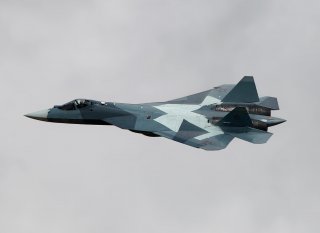Russia’s Su-57 Felon Stealth Fighter Is Getting New Air-To-Air Missiles
The single-seat, twin-engine multirole fifth-generation Su-57 jet fighter was designed for air superiority and attack operations. It can destroy all types of air, ground, and water-based targets.
Photos circulated online earlier this week showing a Russian Su-57 Felon flying without its canopy during a test sortie. The aircraft was part of the Russian Aerospace Forces (RuASF) 929th V.P. Chkalova State Flight Test Center from Akhtubinsk Air Base, which is responsible for the state evaluation of military aircraft as well as weapons platforms.
The test sortie was reportedly part of a “cockpit habitability trial,” which was aimed at testing the emergency escape procedure and not just a way for the pilot to get some “fresh air” while taking in the sights! British Aerospace (BAE) test pilot Keith Hartley had conducted a similar “cockpit habitability trial” with an open-top Tornado XZ630 in 1988—also to test the jet aircraft’s escape procedures.
Russia’s Answer the F-22 Raptor
Unlike other Russian aircraft, the Su-57 has not been exported to date—so details on the plane have remained somewhat murkier than other platforms. Development on the advanced Su-57 began in 2002, but the aircraft only took its first flight in January 2010. As of last year, fewer than a dozen of the aircraft have been produced.
The single-seat, twin-engine multirole fifth-generation Su-57 jet fighter was designed for air superiority and attack operations. It can destroy all types of air, ground, and water-based targets.
The plane, which is the first Russian aircraft to utilize stealth technology, was also designed to have supercruise, supermaneuverability, and advanced avionics to overcome attacks from the prior generation fighter aircraft as well as ground and naval defenses. The aircraft also has supersonic cruise speed, internal weapons bays, radio-absorbing coating, and the newest onboard equipment.
New Missiles Tested
According to reports from The Drive, the Russian Air Force may also be on the verge of introducing significant new air-to-air missile capabilities to the Su-57. Reportedly an online clip showed the fighter jet carrying one or even two of the new variants of the Vympel NPO R-77 medium-range air-to-air missiles. Footage of the Su-57 appeared in an official state produced documentary commemorating the 100-year anniversary of the founding of the 929th V.P. Chkalova State Flight Test Center.
The R-77 medium-range air-to-air missile is the Russian equivalent of the radar-guided U.S. AIM-120 AMRAAM (Advanced Medium-Range Air-to-Air Missile). The R-77 was first introduced in 1991 but it had a severely protracted development. The improved R-77-1 entered service with the Russian Air Force in 2015, and it has been employed on Su-35S fighters in Syria and used during combat air patrols.
The K-77M is the most recent version produced. It features conventional fins, which allow for internal carriage within the Su-57’s weapon bay. The aircraft can carry up to four of the beyond visual range radar-guided missiles.
The upgraded K-77M also has a new dual-pulse rocket motor and an enhanced active electronically-scanned array radar seeker. It has double the range—upwards of 100 miles—of the original R-77, and could also be capable of engaging anti-aircraft missiles including those approaching from the rear. This could certainly give the Su-57 an edge against other aircraft.
Peter Suciu is a Michigan-based writer who has contributed to more than four dozen magazines, newspapers and websites. He is the author of several books on military headgear including A Gallery of Military Headdress, which is available on Amazon.com.
Image: Wikimedia Commons.

